Coolest ad campaign going?
Uh, yes.
Out of the box, RLSAs pair remarketing ads and search ads in a clever tag team execution that makes pure digital marketing sense.
It’s conditional (the second action depends on the first), tightly creative (you speak to a narrow crowd), respectful (higher bids but better conversions), and—dare we say it?—nuanced.
This one’s the Château Margaux Bordeaux in your average wine cellar.
And it’s straight-up fun to drink.
By the end of this article, you’ll know the high-level stuff:
- What Google RLSA is
- How it works
- Why it’s so damn beautiful (the benefits)
And the practical step-by-step stuff
- how to set it up
But you’ll also walk away with twelve of KlientBoost’s finessed Google RLSA best practices for tip-top performance.
Let’s make the most of the Google Search Network with RLSA.
Clink 🥂
Get brand new Google ad strategies straight to your inbox every week. 23,739 people already are!
What is Google RLSA?
Remarketing lists for search ads (RLSA) are customized search ad campaigns targeting only people who’ve checked out your site, landing page, or app before.
Specific, right?
That audience is already aware of who you are, so you tailor your bids and ads to woo them when they search for you (and others like you) on Google search engine result pages (SERP) and search partner sites.
Conversationally, RLSA goes like this:
“Thanks for visiting my site. I’m adding you to my VIP list. That way, when you Google what I sell later, I’ll be there to open the door for you and remind you why you checked me out in the first place.”
RLSAs are a perfect combo of classic display remarketing audiences and high conversion-intent search ads.
With this type of ad campaign, you intentionally splash the pot and make a big show of your bet.
How does Google RLSA work?
- Create an audience list
- Setup up a search ads campaign
- Target that list so that the person must be within the audience AND they’ve typed in that specific keyword you’re bidding on
Here’s the important part: the people in that audience are a select group of hot targets. They’ve shown prior interest in you (how you doin’?), and you’re about to remind them about that interest and give them another reason to pick you.
That reason is that you’re persistent (on top of being awesome).
RLSA works because it combines the best parts of two different advertising networks:
- Audience power
- Search
Think of Google RLSA like a nightclub guest list. The people on that list get special treatment; they skip the line and sit their hot asses down in the VIP lounge of your club. Then, you serve them a complimentary glass of that Margaux we mentioned in the intro.
You may even decide to be more aggressive with your search ads by increasing your bids.
Audience power
Remarketing is a powerful Display advertising tool because it’s one of the most effective targeting methods for lifting brand awareness, website engagement, ad engagement (by as much as 400%), your conversion volume, and your overall conversion rates—by as much as 70%.
Using that power makes your search ads stronger; you show Search ads to users who’ve previously interacted with your website/brand already.
Search
Search ads target those with a higher purchase intent (bottom of the funnel buyers). But the competition on the Search Network is fierce, and the cost per click (CPC) is high.
And that’s what makes RLSA so flipping fantastic.
Google RLSA (remarketing + search)
What happens when you add the classic benefits of Google Display Network remarketing (brand awareness, low cost-per-click) to the high purchase intent and click-through rates (CTRs) of the Google Search Network?
Conversions.
That’s what.
RLSA is an arranged marriage made in ROAS heaven (return on ad spend).
What are the benefits of RLSA?
People browse many websites when they research something, so it’s clever to show them a remarketing ad when they’re somewhere else that pushes them back to your site.
In fact, that push increases the odds that someone will purchase your thing over a competitor by as much as 70%.
That makes remarketing one of the best ways to lift campaign results compared to other targeting methods (like keyword and topic).
But it would be a shame to only use remarketing on the Display Network.
You should use remarketing on ALL of your existing campaigns, especially the ones that drive the most closed conversions (search campaigns).
Why are search users more active and conversion-ready than display network audiences? Because of their intent.
Think of it this way:
When are you more likely to convert?
- When you’re on a random site and a display ad appears—possibly a banner or a sidebar graphic, OR
- When you’re actively typing a specific product name into the Google search bar to comparison shop
Option two has a far greater conversion likelihood, (aka hotter traffic temperature).
Now add remarketing’s customization to the equation and hot becomes super-hot.
Getting ready for Google RLSA
There are a few performance benchmarks you must hit before RLSA becomes an option. And there are some things to keep in mind from a technical perspective.
Basic Google RLSA requirements:
- You must plant 1,000 cookies before your audience list becomes active
- You can use audience lists from your own 1st party data, the audiences already available within Google Ads, or customer match email address lists
- The list membership time limit caps at 540 days
- Bid room: decrease your bids by as much as 90% or increase them by 900%
- If a searcher is on more than one remarketing list, Google uses the higher bid
- Similar to Display Network, choose targeting or observation. Targeting means that the person must be part of the audience list and also type in the keyword you bid on. Observation means that someone ‘not’ on your audience list can still see your ad if they type in the keyword you bid on.
Know your audience before you start
Every marketing tool or tactic starts with strategy. Make sure you understand your target audience and the funnel steps they travel through before converting—and after converting.
Map your PPC customer journey so you know who you’re targeting and when you’re targeting them.
How to set up an RLSA campaign
You know the high level stuff: what RLSA is, who it targets, and why it works—hooah.
Time to get gritty and set these bad boys up.
RLSAs rely on proper Google Ads setup for proper execution (as is the case with all remarketing campaigns).


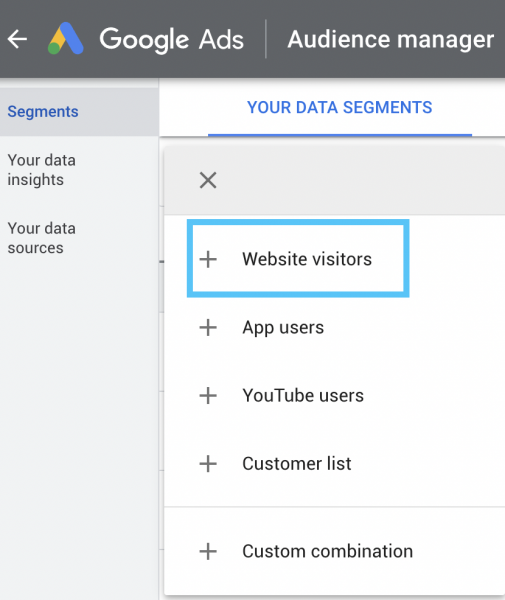
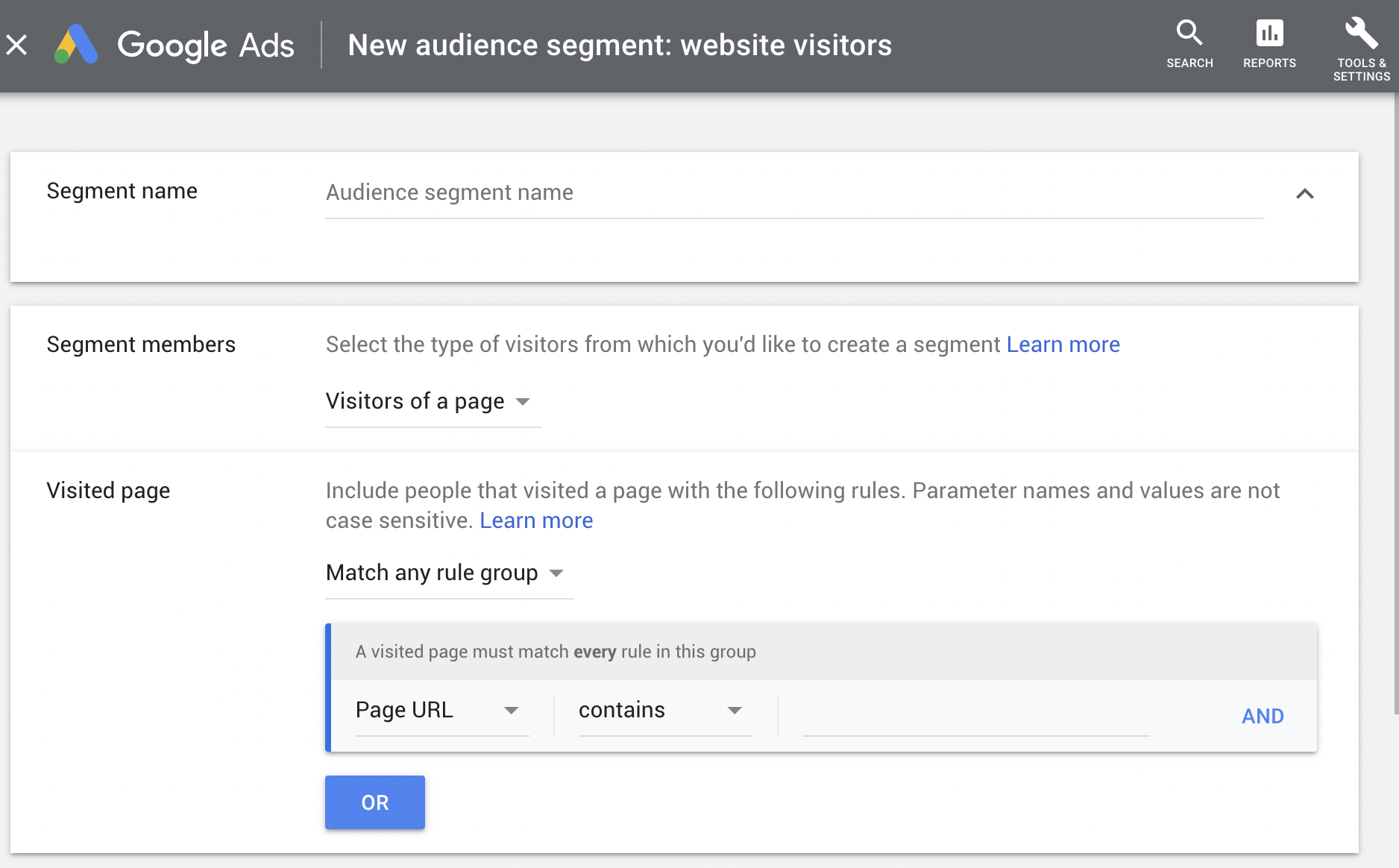
Once you’ve created your audience, go to your Search campaign. Click on your ad group and select Audiences on the left side bar.
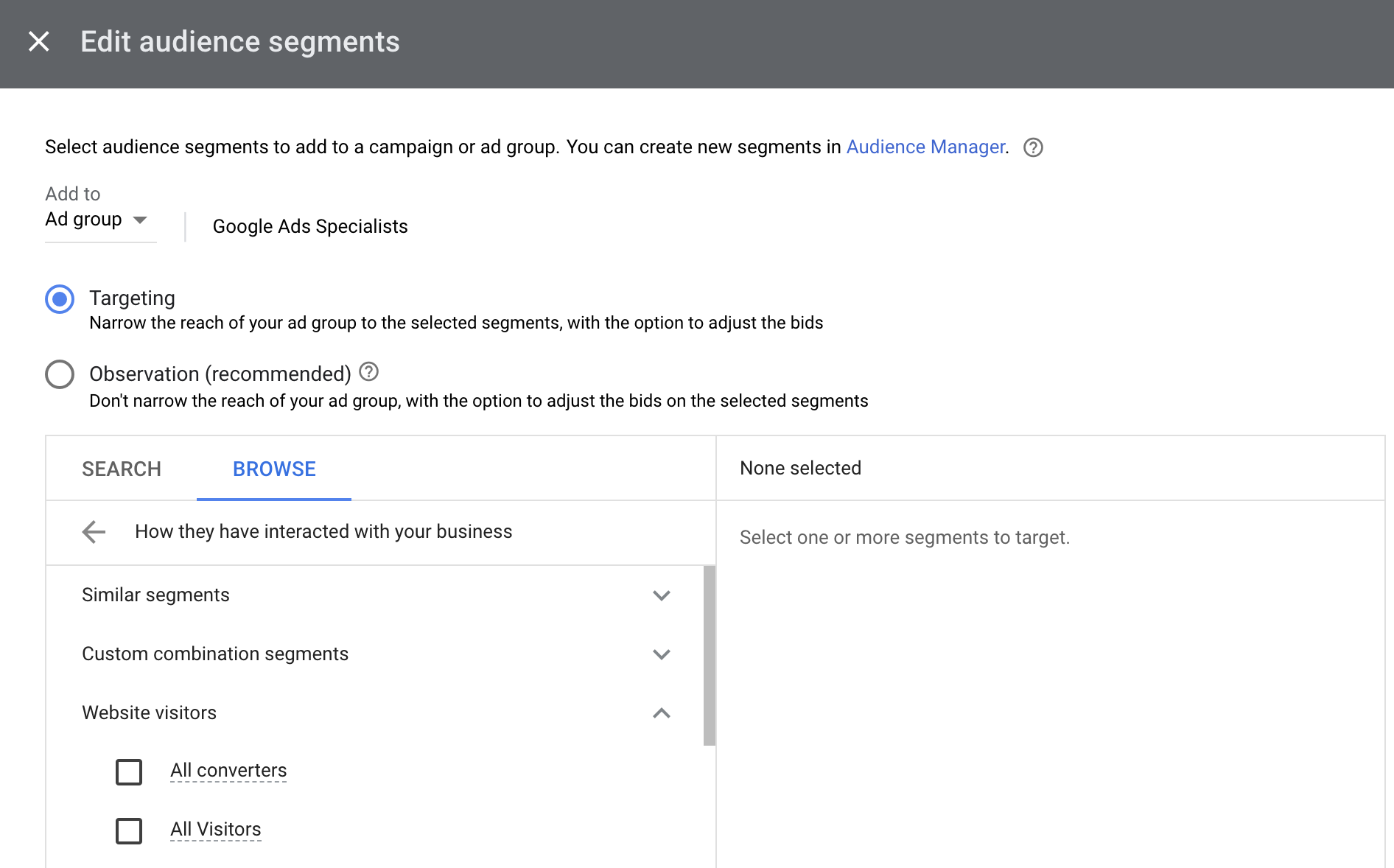
You just set up your RLSA campaign.
RLSA best practices
It’s one thing to set them up and let them run, but it’s another to run them well. Google RLSA best practices increase the performance of your campaigns 🙂
Try these out.
RLSA best practice #1: Compete for broad terms
Some broad keywords have lots of (expensive) competition. Others have too much non-qualified traffic.
With RLSA, you place low bids on broad search terms then increase your bid when you know the audience has been on your site before and is more likely to convert.
Say you’re competing for the broad term “Customer Management.” By using RLSA, you only increase the bid if a visitor has visited the site before. That’s how you achieve top rankings if a conversion is more likely and not have to pay out as much ad spend for colder traffic.
Read more about PPC traffic temperatures here.
RLSA best practice #2: Demographic targeting
The Display Network lets you target ideal demographics (like age and gender). But the Search Network isn’t only about keywords. You can adjust your bids up for your ideal audience, or adjust down based on age or gender to fit your ideal buyer.
For example, this client’s product mostly appealed to female customers, so we increased our bids for females that are between 18-54 and negative bid males and women over 55.

You will almost always have a percentage of “unknown visitors,” but optimizing the majority of your traffic by age and gender is a no-brainer.
Learn more about targeting for demographics and other criteria here.
RLSA best practice #3: Turn up the heat
As a visitor gets closer and closer to conversion, it makes sense to modify your bid.
You may have search terms suited to the consideration/research phase. If the user comes back to your site multiple times, or stays longer, or shows conversion intent, increase your bids as you push for the conversion.
Here are three audience examples where we would adjust our bid as a visitor comes back to the site multiple times and shows behavior that’s nudging closer to conversion:
First Time Users
Behavior: New Sessions
Adjustment: Increase Bid 10%
Consideration
Behavior: 60+ Seconds On Site
Adjustment: Increase Bid 15%
Ready to Convert
Behavior: Clicked ‘Get Demo’
Adjustment: Increase Bid 20%
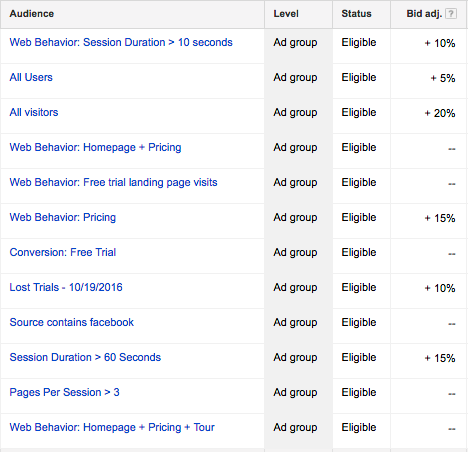
Experiment with different keywords and remarketing lists. You can make educated guesses about what will lead to conversions, but you should always follow the data when you have it. If the data shows it, increase your bids as a visitor gets closer and closer to conversion.
RLSA best practice #4: Message matching
Use specific ad copy based on how users interact with your website. Create a remarketing tag based on the behavior or stage of your visitor. Then modify the bid within an ad group to show more relevant ad copy to that searcher.
For example:
If a visitor looks at your pricing or product page, use RLSA to target them with a discount ad in the SERP (search engine results pages). If they look at a specific feature of your service page, show ads that elaborate on the benefit of that feature.
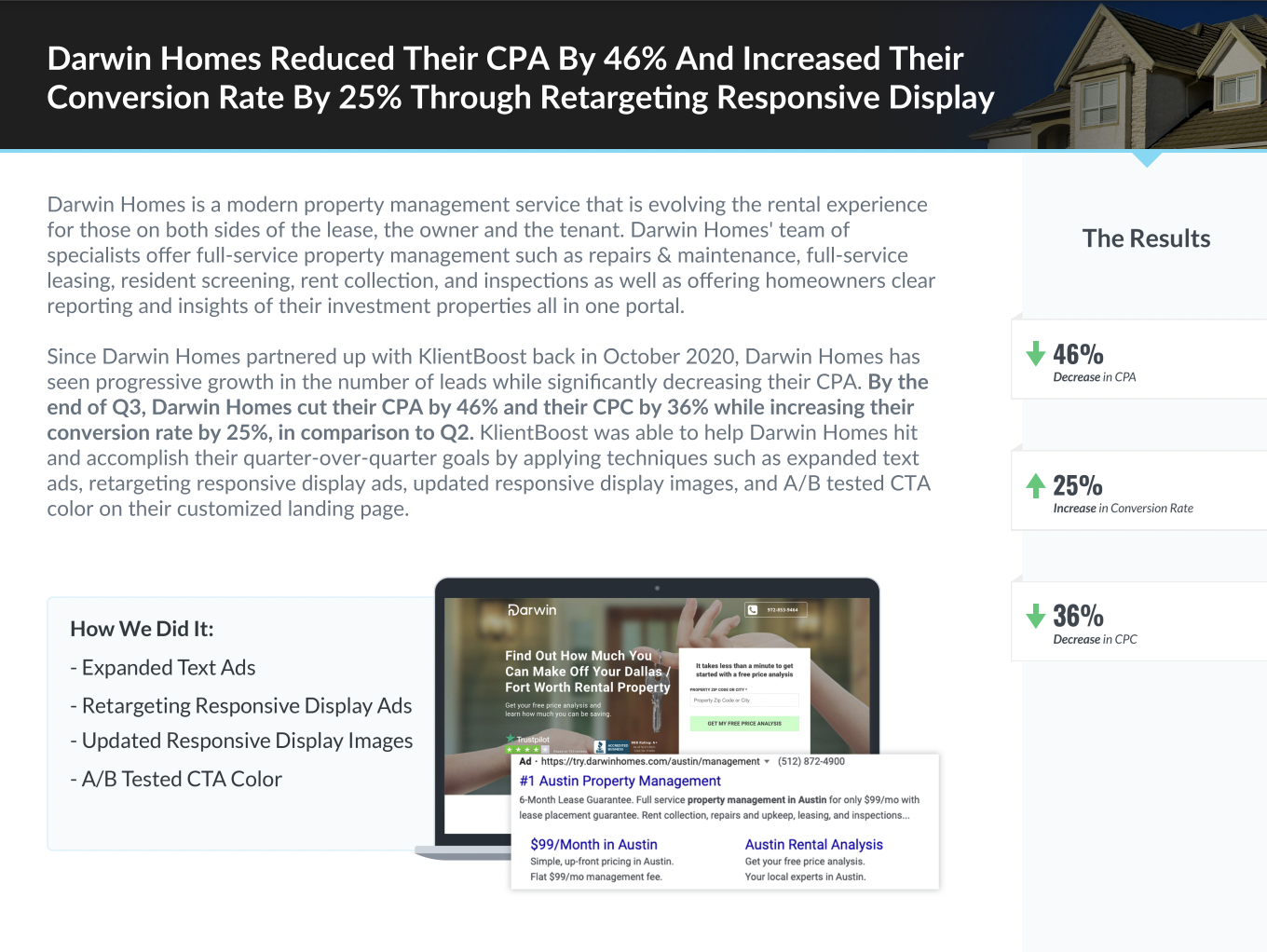
One of our clients, Darwin Homes, reduced their CPA by 46% and increased their conversion rate by 25% in part because of retargeted responsive display ads that matched the landing page.
Read more about ad and landing page message match here and here.
RLSA best practice #5: The bouncer
You don’t always have to bid up. Use negative bids to exclude the wrong audience type, or to prevent them from clicking on your ads.
For instance:
A user that clicks your ad but bounces from your site quickly isn’t likely to convert. You may have email subscribers or unqualified leads that you wouldn’t expect to convert on your ads either. Exclude or negative bid them to prevent wasted spend.
Maybe you have a support page or a SaaS platform with a login for existing customers. On the Search Network, visitors who click your branded ads to get there cost you money. So set up a negative bid adjustment to exclude them so you don’t waste your ad dollars.
If your business has mostly one-time buyers or converters, exclude converters from your search campaigns, saving your ad dollars as shown below:

RLSA best practice #6: Competitor terms
Similar to the broad terms best practice (#1), you can target branded competitor terms on Search then use RLSA to show ads only to searchers who’ve been on your site already.
Those searchers are clearly comparison shopping if they’re looking at your competition and they’ve been to your site before.
Keep in mind that once you start targeting competitor terms, they might start bidding on your branded terms as well. But hey, competition is expected in a free market 🙂
RLSA best practice #7: Shopaholics
RLSA on shopping campaigns give you a tactical advantage. Bid more on searchers who’ve already shown interest in high-value items or who’ve abandoned their shopping carts.
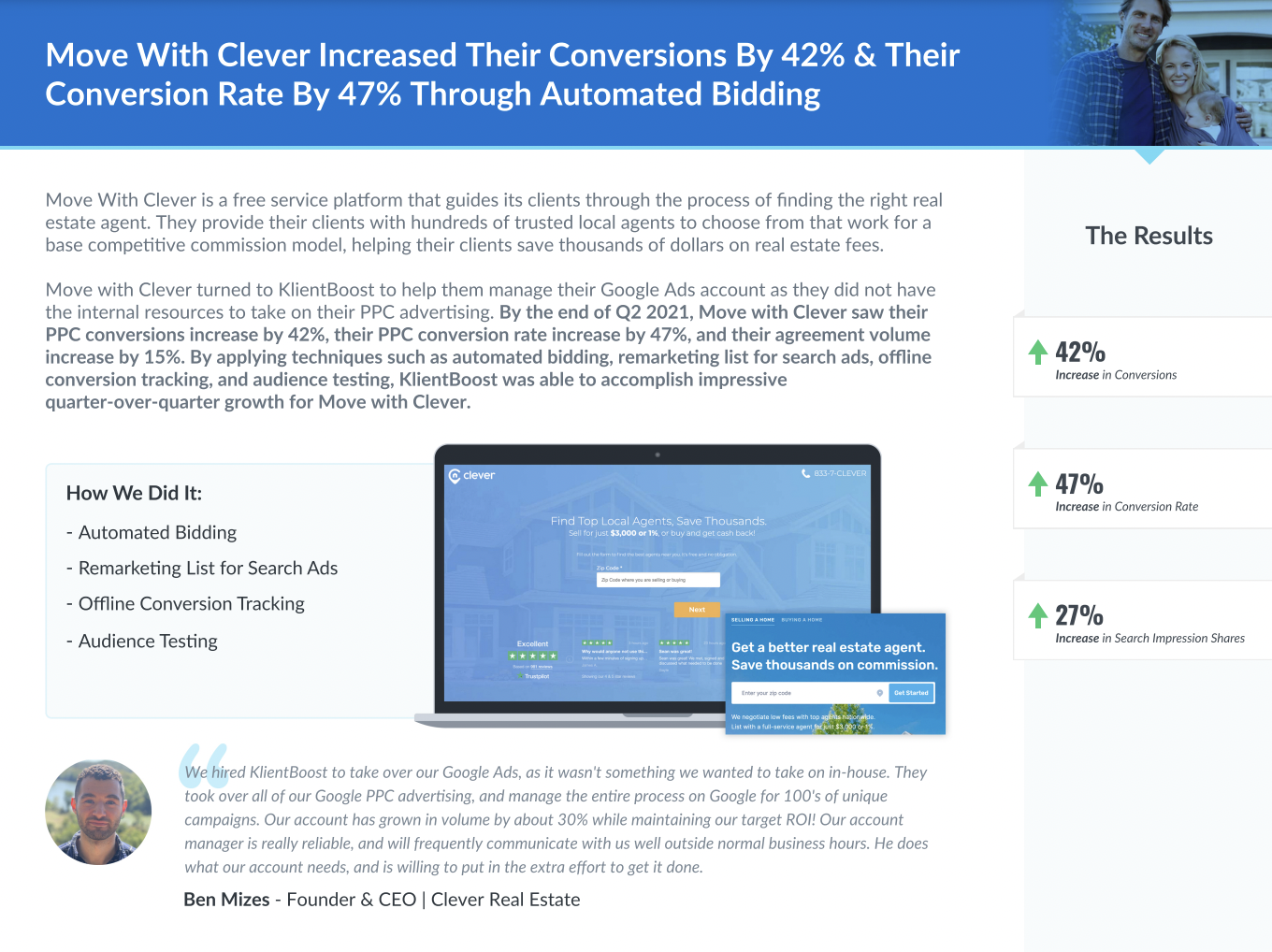
One of our clients, Move With Clever, increased conversions by 42%, in part because of RLSAs.
Here’s another example of a client who had a 128.28 ROAS (return on ad spend) vs a 28.52 ROAS on their shopping campaign:
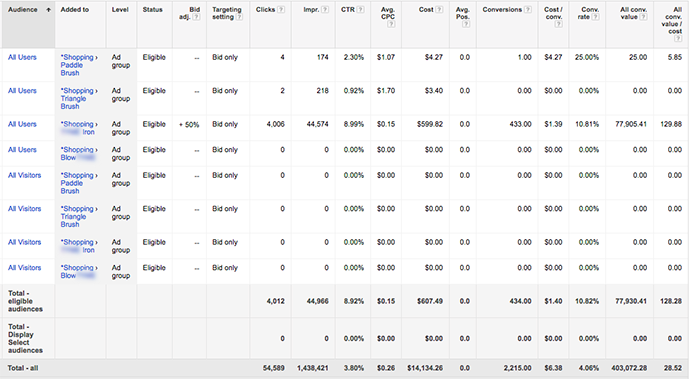
RLSA best practice #8: VIP only
If you want super-targeted clicks on the Search Network, you’ll show your search ads ONLY to searchers who have a remarketing cookie using “targeting.”
But! Doing that excludes ALL other searchers, which massively reduces your impressions.
What to do?
Supplement low impression volume with lots of cheap social traffic. Send that social traffic to your pages, then use the remarketing tag to show RLSA ads to your ideal audience, even for broad terms.
Learn more about Google Ads bidding strategies here.
RLSA best practice #9: RLSA + DSA = RLSADSA? 😜
Dynamic Search Ads (DSA)
A Dynamic Search Ads campaign is great for broadening your keyword footprint and bringing in more traffic. Problem is, the traffic that clicks on your ad may not be your ideal audience, making those clicks expensive.
RLSA+DSA to the rescue.
RLSADSA 👀
Mix RLSA with your DSA campaign to [✨magic wand✨] only show DSA ads to visitors who already know your company.
Retailer Grainger combined RLSA and DSA for stellar results. Return on ad spend (ROAS), conversions, and click-through rates (CTR) all increased by nearly 1,000%.
One of our own clients used RLSA on their DSA campaigns. The RLSA audiences had a 13.83 ROAS vs cold traffic with a 2.05 ROAS.

Advanced technique: create ad groups based on your RLSA lists. Then, use “targeting” to gain insights into what search terms they use post-visit.
RLSA best practice #10: Social + RLSA or RLSA Only
When should you do RLSA Only? If your vertical has higher click costs (CPCs), lots of competition, and challenging conversion rates.
Only use RLSA and completely forget about unbranded search ads, then use social media ads to increase the size of your remarketing pool. If your pool is bigger, the conversions odds go up.
Alternatively, start off with social and then apply RLSA.
Just as you increase bids for shopping cart abandoners and purchasers you want to upsell/cross-sell, you can also increase bids for users who convert in your Facebook audience.
If a user shows a history of conversions, there’s a better chance they’ll convert again compared to a user who has never converted.
For example, an eCommerce dental supply website ran Facebook ads to find new potential customers who didn’t yet know their brand. They collected data that could be used in a remarketing list and applied it as an RLSA bid adjustment on search campaigns.
Note: When you run Facebook campaigns, set a Google Analytics UTM tracking code with a label like “top converting.” This makes it easy to pick out later when you set up a remarketing list based on the traffic source that matches that campaign.
If the user converts on a Facebook ad AND searches in Google for “dental supplies,” 👏 remarket 👏 to 👏 them.
Does this work for all brands? It probably has a better chance of success if your brand drives higher conversion volume from Facebook advertising.
Note: Bid adjustments stack, so there’s crossover that can impact bids across similar audiences.
RLSA best practice #11: The journey doesn’t end
In addition to #7 Shopaholics, if a purchaser visits a “Thank you for your purchase” page, a retailer can bid on terms they normally wouldn’t because they’re low-profit margin, low-cost products like device accessories.
Create a search campaign with an ad group that includes potential search terms and phrases for upsells and cross-sells. Set up ‘Target and Bid,’ so the targeted user has to meet both criteria:
- they land on the checkout completion page and
- they search for one of those terms
It’s a two-for-one deal.
For instance, say someone buys a new red dress from Macy’s, an apparel store that sells both dresses and shoes. Macy’s could create an RLSA list that targets the dress buyer and others who have completed a purchase for red dresses (assuming they might want matching shoes).
It’s an assumption; they can’t know for sure based on the red dress purchase alone.
But that assumption gets hotter if the red dress buyer then searches for “red shoes” in Google SERP.
Macy’s money is best spent on those with a high interest in an upsell or cross-sell product, so they only show ads to those who have BOTH bought the red dress and are searching for “red shoes” in their browser.
But what about if a retailer sells a product with a high margin?
Let’s say you have a search campaign for bicycle helmets, and the margin is higher than other products in your store. Create a duplicate campaign and name it “RLSA Bicycle Helmets” to focus that list specifically on those who visited the bicycle helmets category page.
To make sure that the RLSA campaign doesn’t compete with the original search campaign, create a negative remarketing list and apply it to that original campaign.
Without it, Google decides what ads show up based on bids and Quality Score. But since you are the captain of your own ship, you’ll take control over your campaigns’ success 🙌
Bonus best practice #12: The Bottom Feeding Approach
RLSAs take the most relevant users and hit them with highly-targeted ads for content we know they’re already interested in 👈✨🍾
But RLSAs aren’t the only way to go after bits of leftover search traffic that may have escaped your primary lead generation campaigns on the Google Search Network.
When we first developed single keyword ad groups (SKAGs), we didn’t know how they’d evolve. Now we do. We call the next step the Bottom Feeding Approach.
The Bottom Feeding Approach leverages Broad Match keyword targeting with Exact Audience Targeting to eat up all the leftover search traffic that your previous SKAGs would have filtered out.
You may get a bunch of other search terms “caught in the net.” But you’ll also be able to find the last few valuable conversion-ready search terms you didn’t know were golden eggs before.
Listen to the BoostSauce podcast for the Bottom Feeding Approach by clicking the link. Or, if you’re in a more playful mood, go fishing with Captain Spencer and 👇 watch the quick video 👇
Google RLSA optimization
RLSA optimizes your bids to be more targeted on the Search Network. Using remarketing lists and demographics targeting on the Search Network lets you target your ideal audience in a refined way.
That being said, don’t blindly increase bids or decrease bids based on a best guess of what your audience will do—always follow the data.
Use RLSA best practices to exercise more control over the Search Network.
Let us know about any other creative ways you’ve used Google RLSA to enhance your campaigns.